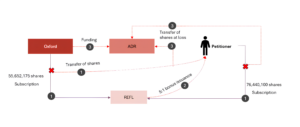Telangana High Court’s Landmark Judgement on GAAR: A new Era in Tax Avoidance Litigation

In June 2024, the Telangana High Court delivered a landmark judgement in the case of Ayodhya Rami Reddy Alla v. Principal Commissioner of Income-Tax (“Reddy Case”), marking a significant turning point in the application of General AntiAvoidance Rules (“GAAR”) in India. This case stands as the first substantial interpretation of GAAR since its introduction in 2017, offering critical insights into its scope, application, and interplay with other tax avoidance provisions.
The judgement upheld the actions of the tax authorities in initiating GAAR proceedings against the taxpayer, despite the presence of specific provisions in the Income Tax Act, 1961 (“IT Act”) addressing bonus stripping transactions. The judgement, therefore, sets a significant precedent for the application of GAAR and its interaction with other antiavoidance rules in future cases.
Key Highlights of the Reddy Judgement
Application of GAAR
The High Court upheld the applicability of GAAR, emphasizing that its provisions could take precedence even in the presence of specific anti-avoidance measures. This signals a broader interpretation of GAAR’s scope, potentially widening its use as a tool to combat tax avoidance.
Interplay of GAAR with other Anti-Avoidance Rules
The High Court explored the relationship between GAAR, Specific Anti-Avoidance Rules (“SAAR”), and Judicial AntiAvoidance Rules (“JAAR”), concluding that GAAR could supersede SAAR under certain circumstances.
Evolution of Anti-Avoidance Provisions in India:
Prior to the introduction of GAAR, tax avoidance was typically tackled through a combination of principles: (i) JAAR i.e., judicial principles developed through various pronouncements by different Indian courts essentially based on the concepts of “substance over form”, “conduit”, “devices” and (ii) SAAR i.e., specific statutory provisions dealing with identified arrangements and transactions of tax avoidance. GAAR, effective from 1 April 2017, offers a codified framework, allowing tax authorities to disregard the form of a transaction / arrangement where its main purpose is to obtain a tax benefit, and it satisfies at least one of the four prescribed tests: (i) creates rights or obligations which are not at arm’s length, (ii) results in misuse or abuse of the provisions of the IT Act, (iii) lacks commercial substance and (iv) is not for bona fide purposes.
Facts Leading to the Reddy Case
The Reddy Case revolved around a series of transactions engaged in by the petitioner, Mr. Ayodhya Rami Reddy (“Mr. Reddy”), which resulted in significant tax benefits:
Issuance and Transfer of Shares: During the Financial Year (“FY”) 2018-19, Ramky Estate and Farms Limited (“REFL”) issued shares to Mr. Reddy and Oxford Ayyapa Consulting Services Private Limited (“Oxford”). Oxford subsequently transferred its shares to Mr. Reddy. These shares along with the shares originally issued to Mr.Reddy formed the “Initial Lot”.
Bonus Shares Issuance: REFL issued bonus shares in a 5:1 ratio, resulting in a drastic decline in the per share value. According to Indian tax laws, bonus shares do not carry any cost of acquisition, while the cost of acquisition of the Initial Lot remained unchanged.
Sale of Shares: Mr. Reddy sold shares from the Initial Lot to Advisory Services Private Limited (“ADR”) at a significant loss, claiming a short-term capital loss of INR 4,620 million. Tax authorities alleged that Oxford funded the purchase by ADR. Intercompany Deposit: In addition to the above transactions, a deposit was issued by Mr. Reddy to a group entity during the same FY, most of which was written off shortly after the issuance of deposit.
Offsetting Gains and Losses: Mr. Reddy offset the losses from these transactions against gains from the sale of shares in another company, Ramky Enviro Engineers Limited (“REEL”).
The transaction steps are set out below:

Writ petition before the High Court: During tax assessment, the tax authorities made a reference for scrutiny under GAAR with respect to the set off of losses claimed by Mr. Reddy. Mr. Reddy approached the High Court by way of a writ petition against the initiation of GAAR proceedings.
Decision of the Telangana High Court
The High Court upheld the tax authorities’ initiation of GAAR proceedings, making several key observations:
Special v. General Provision: The principle that a special provision overrides a general provision was deemed irrelevant by the High Court in this case. While a special provision generally overrides the general provision, the High Court noted that this principle has been upheld where the general provision subsists and a special provision is subsequently introduced. The High Court held that the facts of the Reddy Case were different wherein Section 94(8) of the IT Act, which restricts the set-off of losses in certain circumstances, already existed before GAAR was introduced. Hence, the principle of special provision overriding general provision cannot be adopted.
Non-Obstante Clause: Section 95(1) of the IT Act, the substantive provision for application of GAAR, contains a non-obstante clause, which allows it to override other provisions of the IT Act.
SAAR v. GAAR: The High Court dismissed the argument that SAAR should take precedence over GAAR. It determined that specific anti-avoidance provisions did not apply to shares during the relevant period, which left GAAR as the applicable provision.
JAAR: Citing the Supreme Court’s judgement in McDowell & Co. Ltd. v. CTO3 case, the High Court reiterated that tax avoidance through dubious methods cannot be tolerated.
Key Issues with the High Court’s Judgement
Can GAAR Overcome a gap in Legislation or the intent of Lawmakers?
The judgement arguably overlooks the legislative intent behind Section 94(8) of the IT Act for FY 2018-19. This section, which was amended in 2022 to include shares and stocks, initially only applied to mutual funds in respect of wash transactions. By applying GAAR to share transactions before 2022, the judgement in effect introduces a retrospective application of SAAR through GAAR. If the intent of the lawmakers was to make Section 94(8) of the IT Act apply for shares and stocks for prior periods, that would have been specifically introduced when the provision was amended.
Alignment with International Jurisprudence
The High Court’s approach diverges from international jurisprudence that GAAR should be seen as an interpretative tool to tax transactions basis the object of the provisions. The Supreme Court of Canada4 provides that GAAR is to be applied through a two-step process: First, interpreting the object, spirit and purpose of the tax provisions relied upon and Second, a factual analysis to determine if the transaction undermines these objectives. The judgement seems to have skipped the first step, failing to analyze the object, spirit, and purpose of the specific provisions in question.
Interplay of SAAR and GAAR
The High Court’s judgement suggests that GAAR can apply even if SAAR does not explicitly prohibit a transaction. However, it did not fully consider that Section 94(8) of the IT Act was initially limited to mutual fund units and was later amended to include stocks. According to the FAQs released by the Central Board of Direct Taxes (“CBDT”) on January 27, 20175, GAAR and SAAR can coexist and be applied as necessary, depending on the facts and circumstances of each case. However, in the Reddy Case, the High Court did not fully appreciate that Section 94(8) of the IT Act, which by itself was a specific anti-avoidance provision, was initially limited to mutual fund units and only later expanded to include shares. This oversight raises questions about the appropriate application of GAAR in the presence of specific anti-avoidance rules.
Interpretation of the Shome Committee Report
The High Court’s interpretation that the Shome Committee Report pertains only to international agreements is narrow and restrictive. The Committee’s recommendations were intended to apply to both domestic and international contexts, with an emphasis on ensuring that GAAR should only be invoked when SAAR is not applicable. In this context, the Committee provided that: “In view of the above, the Committee recommends that where SAAR is applicable to a particular aspect/element, then GAAR shall not be invoked to look into that aspect/element. Similarly, where antiavoidance rules are provided in a tax treaty in the form of limitation of benefit (as in the Singapore treaty) etc., the GAAR provisions shall not apply overriding the treaty. If there is evidence of violations of anti-avoidance provisions in the treaty, the treaty should be revisited, but GAAR should not override the treaty”.
Application of JAAR in the Presence of GAAR
The High Court referred to various judgements where common law principles were used to deny tax reliefs, which were relevant before the codification of GAAR. With the onset of GAAR, when should JAAR be invoked? The principles of JAAR should be applied only when GAAR is not applicable. In the Reddy Case, the confabulation of the principles relating to JAAR for interpretation of the provisions of GAAR was unnecessary and arguably incorrect since any interpretation of the provision of GAAR has to be based on the codified provisions.
Key Takeaways from the Reddy Case
Commercial Rationale: The lack of a cogent commercial rationale increases the risk of GAAR being invoked. Taxpayers should ensure that the transactions have a legitimate commercial purpose.
Documentation: Contemporaneous documentation supporting the commercial rationale of any arrangement is crucial for taxpayers to counter the application of GAAR.
Interplay of Rules: The judgement highlights the complex relationship between GAAR, SAAR, and JAAR. While the High Court’s reliance on JAAR in a case primarily concerning GAAR initiation has added to this complexity, taxpayers must navigate these provisions carefully, as reliance on one set of rules over another can have significant tax implications.
Policy Implications and Future Considerations
Selective Application of GAAR: It is crucial that GAAR be applied selectively, taking into account the specific facts and circumstances of each case. The judgement in the Reddy Case should not set a precedent for broad application of GAAR across all tax avoidance scenarios.
Clarity and Consistency: There is a need for clearer guidelines to ensure that GAAR is not applied where SAAR is already in place. This would help avoid ambiguity and ensure that tax laws are applied consistently.
Judicial Oversight: The ongoing appeal before the Supreme Court will be critical in determining the appropriate scope of GAAR. The Supreme Court’s judgement will likely provide much-needed clarity on its application and the relationship between GAAR and other anti-avoidance rules.
Conclusion
The Ayodhya Rami Reddy Alla v. Principal Commissioner of Income-Tax case marks an important development in the application of GAAR in India. The judgement underscores the broad scope of GAAR in combating tax avoidance but also highlights the complexities involved when it intersects with other anti-avoidance provisions. As the legal landscape around GAAR evolves, it must be ensured that GAAR is applied with clarity and consistency to achieve its intended purpose without unduly burdening taxpayers. The upcoming Supreme Court appeal will provide further guidance, offering an opportunity to refine and balance the application of GAAR in future cases.




